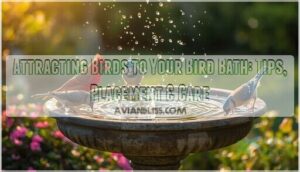This site is supported by our readers. We may earn a commission, at no cost to you, if you purchase through links.

Small parrots like budgies typically live 5-15 years, while medium-sized cockatiels can reach 15-25 years.
Large parrots are the real showstoppers—African Greys and macaws often live 50-80 years, with some reaching 100.
That’s potentially a lifetime commitment that could outlast you!
Size matters when asking how long do parrots live, but proper nutrition, veterinary care, and mental stimulation play huge roles too.
Poor diet and stress can cut decades off their natural lifespan.
The secret to maximizing your parrot’s years involves specific care strategies most owners overlook, and understanding that poor diet can have significant impacts.
Table Of Contents
- Key Takeaways
- Parrot Lifespan Overview
- How Long Do Parrots Live
- Parrot Species Lifespan
- Factors Affecting Parrot Longevity
- Improving Parrot Lifespan
- Frequently Asked Questions (FAQs)
- Can a parrot live for 100 years?
- Can parrots live 200 years?
- Can a parrot live 150 years?
- Do wild parrots live longer than captive ones?
- Can parrots die from loneliness or depression?
- What age do parrots reach sexual maturity?
- How do you tell a parrots age?
- Do male and female parrots have different lifespans?
- Conclusion
Key Takeaways
- You’ll find parrot lifespans vary dramatically by size—small budgies live 5-15 years while large macaws can reach 100 years, making them potentially lifetime companions that could outlast you.
- Your parrot’s diet directly impacts their longevity, with proper nutrition including quality pellets, fresh vegetables, and avoiding toxic foods like chocolate and avocado being essential for maximizing their lifespan.
- You can significantly extend your bird’s life through regular veterinary check-ups every six months, which catch diseases early before symptoms appear and provide preventative care.
- Your parrot needs daily mental stimulation and social interaction to thrive—isolated birds develop stress-related illnesses that can shorten their lives, while enrichment activities and bonding prevent behavioral issues.
Parrot Lifespan Overview
You’re probably wondering how long your feathered friend will share your life, and the answer might surprise you.
Most parrots live between 20 to 80 years, with some species like macaws reaching over 100 years in captivity when given proper care.
Most parrots become lifelong companions, with some macaws outliving their human families by decades.
Average Lifespan of Parrot Species
You’ll find dramatic differences in parrot lifespan across species.
Small parrots like budgies average 5-10 years, while medium species such as cockatiels reach 15-25 years.
Large parrots including African Greys can live 50-80 years, with some macaws exceeding 100 years in captivity.
Size correlation strongly influences longevity extremes – bigger birds generally outlive smaller ones substantially, showing a clear size correlation and significant impact on parrot lifespan.
Factors Influencing Longevity
Understanding what affects your parrot’s longevity helps you provide better care.
Genetic predisposition plays a role, but you can influence many factors.
Stress reduction through consistent routines improves parrot life expectancy.
Exercise benefits include stronger hearts and muscles.
Disease prevention with regular vet visits extends parrot lifespan.
Mental stimulation keeps birds sharp and healthy longer, which is crucial for stress reduction and overall wellbeing.
Importance of Nutrition and Care
Providing proper nutrition and care isn’t just helpful—it’s essential for maximizing parrot longevity.
A balanced diet with fresh fruits, vegetables, and quality pellets forms the foundation of parrot health.
Regular veterinary visits catch problems early, while mental stimulation prevents boredom-related issues.
Creating a safe environment with a healthy space directly impacts your parrot’s life expectancy and overall well-being.
How Long Do Parrots Live
Parrots can live surprisingly long compared to most pets, with lifespans ranging from 15 to over 100 years depending on the species.
Wild parrot longevity often differs from captive parrot lifespan due to environmental factors. Macaw lifespan can reach 75-100 years, while cockatoo lifespan averages 60-80 years, and African grey lifespan typically spans 50-80 years. Parrot aging varies substantially between species and environments.
Here’s what makes parrot longevity remarkable:
- Your feathered friend might outlive you – some parrots become multi-generational family members
- They’re living time capsules – witnessing decades of family memories and changes
- Long-term commitment becomes reality – caring for a parrot often spans multiple life phases
Parrot mortality causes include poor nutrition, lack of veterinary care, and environmental stress. Longevity genetics play a vital role, but proper care substantially impacts parrot age outcomes in captivity.
Parrot Species Lifespan
You’ll find that different parrot species have vastly different lifespans, ranging from 10 years for smaller birds to over 100 years for large macaws.
Understanding these variations helps you choose the right companion and prepare for the long-term commitment that comes with parrot ownership.
African Greys and Amazon Parrots
African Grey parrots live around 60 years, with some reaching 80.
Their Grey Intelligence makes them exceptional talkers, but this creates Captivity Challenges requiring mental stimulation.
Amazon parrots average 50-70 years with vibrant Amazon Temperament.
In Species Comparison, African Greys excel in Talking Ability while Amazons shine socially.
Both species demonstrate impressive parrot longevity when provided proper care and enrichment activities.
Macaws and Cockatiels
Macaws and cockatiels show striking differences in parrot species lifespan. Your macaw care directly impacts their captive longevity – these giants can reach 100 years while cockatiels typically live 15-25 years.
Consider how long parrots live based on size:
- Scarlet macaws: 40-75 years in captivity
- Blue and Gold macaws: 40-100 years with proper care
- Cockatiels: 15-25 years average, up to 36 recorded
- Wild threats reduce lifespans substantially
Small Parrots and Their Lifespan
In the case of smaller feathered companions, you’ll find their lifespans vary substantially.
Budgie lifespan typically ranges from 5-15 years, while cockatiel longevity extends 10-20 years with proper care.
Lovebird years average 10-15, and parrotlet health supports 20-30 year lifespans.
These petite parrots require dedicated conure care to reach their full potential, proving size doesn’t always determine longevity.
Large Parrots and Their Lifespan
Big birds pack impressive longevity that’ll surprise you.
Macaw longevity reaches 50-60 years, with some hitting 100 in captivity.
Amazon lifespans stretch 25-75 years, while Cockatoo ages span 20-60 years.
Captive vs. wild conditions dramatically affect parrot life expectancy.
Your average parrot lifespan varies by parrot species lifespan, but genetic influence plays a major role.
The oldest parrot records show these feathered friends measure parrot years in decades.
Factors Affecting Parrot Longevity
Your parrot’s lifespan depends on several key factors that you can control through proper care and attention.
The quality of their diet, living environment, veterinary care, and social interaction all play important roles in determining how long your feathered friend will live.
Diet and Nutrition
What you feed your parrot directly impacts how long they’ll live.
A balanced parrot diet with 50-70% pellets, fresh vegetables, and limited fruits prevents nutritional deficiencies that shorten lifespan. Avoid toxic foods like chocolate and avocado.
Consistent feeding schedules support parrot health, while proper hydration importance can’t be overlooked.
Some birds need supplement needs addressed through veterinary guidance for guaranteed parrot nutrition. Providing quality parrot pellets can guarantee they receive essential nutrients.
Environment and Habitat
Your parrot’s environment dramatically impacts their lifespan potential.
Wild habitats offer natural challenges but expose birds to environmental threats like predation and habitat destruction.
Captive environments can extend bird longevity when properly managed.
Habitat enrichment through varied perches, toys, and mental stimulation mimics natural conditions.
Conservation efforts protect wild populations while proper bird habitats guarantee your feathered friend thrives for decades.
Veterinary Care and Health Check-Ups
Three key checkups protect your parrot’s future.
Annual avian veterinary visits catch hidden diseases before they spread.
Preventative care includes blood tests, parasite control, and behavioral issue assessments that directly impact parrot longevity.
Emergency treatment becomes less likely when you prioritize disease prevention.
Regular bird health monitoring helps your feathered friend live decades longer through proper avian health management.
Socialization and Interaction
Your parrot’s social needs directly impact their lifespan.
Birds that receive daily interaction and bonding techniques live longer than isolated ones.
Enrichment activities prevent behavioral issues while supporting parrot intelligence.
These social creatures establish vocal communication patterns and attention-seeking behaviors.
Understanding parrot behavior helps you provide proper parrot training and communication, creating the social hierarchy they crave for peak health.
Improving Parrot Lifespan
You can substantially extend your parrot’s life by making simple changes to their daily care routine.
Proper nutrition, regular vet visits, mental stimulation, and a safe living space are the key factors that help parrots reach their maximum lifespan potential.
Providing a Balanced Diet
Your parrot’s dinner plate directly impacts how many birthdays you’ll celebrate together.
Your feathered friend’s diet today determines how many decades you’ll share tomorrow.
Quality parrot nutrition means fresh fruits, vegetables, and high-grade pellets while avoiding toxic foods like chocolate and avocado.
Watch portion control to prevent obesity.
Consider supplement needs based on your vet’s advice.
Nutritional deficiencies shorten bird longevity, so balance matters for ideal pet bird care.
Creating a Stimulating Environment
Environmental enrichment substantially impacts your parrot’s mental health and longevity.
A stimulating habitat prevents boredom-related behaviors that can shorten lifespan. Smart cage design with varied perches, toys, and foraging opportunities keeps your bird engaged daily.
To further enhance their environment, consider innovative parrot enrichment.
Essential enrichment elements:
- Foraging Opportunities – Hide treats in paper cups or puzzle feeders
- Mental Stimulation – Rotate toys weekly and provide problem-solving challenges
- Social Interaction – Schedule daily out-of-cage time for bonding
Scheduling Regular Veterinary Check-Ups
Regular vet visits aren’t just smart parrot care—they’re lifesavers.
Schedule check-ups every six months for early detection of parrot diseases before symptoms appear.
Your avian veterinarian provides preventative care through diagnostic testing and health screenings.
They’ll also prepare emergency preparedness plans and offer specialist referrals when needed.
This proactive approach to pet health substantially extends your parrot’s lifespan through consistent avian health monitoring, which is a key part of parrot care.
Ensuring a Safe and Healthy Living Space
Safety transforms your parrot’s world from risky to remarkable.
Choose spacious Cage Size that allows wing stretching and flight.
Remove Toxic Hazards like Teflon cookware, avocado, and chocolate from their environment.
Provide Perch Variety with different textures and diameters to prevent foot problems.
Maintain excellent Air Quality by avoiding aerosols and cleaning chemicals.
Consider adequate space requirements for your parrot’s well-being.
Include daily Enrichment Activities to prevent boredom and behavioral issues in your parrot habitat.
Frequently Asked Questions (FAQs)
Can a parrot live for 100 years?
Like timeless treasures, some parrots can indeed reach the century mark.
You’ll find that captive scarlet macaws have documented lifespans approaching 100 years with proper care, nutrition, and veterinary attention throughout their remarkably long lives, making them a true marvel of long lives.
Can parrots live 200 years?
No, parrots can’t live 200 years.
While some captive parrots might reach 100 years with exceptional care, 200 years exceeds their biological limits.
Most parrots live 50-80 years, making them long-lived but not bicentennial companions.
Can a parrot live 150 years?
Most parrots can’t reach 150 years, but some can.
Large species like macaws might live 80-100 years with excellent care.
You’ll find that exceptional cases exist, though they’re rare and require perfect conditions throughout their lifetime.
Do wild parrots live longer than captive ones?
Wild parrots typically don’t live as long as captive ones. You’ll find most wild parrots face predators, diseases, and habitat challenges that reduce their lifespan compared to well-cared-for pet parrots.
Can parrots die from loneliness or depression?
Yes, parrots can die from loneliness and depression.
These social birds need companionship and mental stimulation.
Without proper interaction, they’ll develop stress-related illnesses, stop eating, and experience weakened immune systems that can prove fatal.
What age do parrots reach sexual maturity?
When do feathered friends become ready to start families?
Most parrots reach sexual maturity between 2-5 years old, though larger species like macaws take longer—sometimes up to 8 years before they’re ready to breed.
How do you tell a parrots age?
Determining your parrot’s age requires veterinary examination of their beak, eyes, and feet. Young birds have smooth beaks and bright eyes, while older ones show wear patterns and duller coloring.
Do male and female parrots have different lifespans?
Male and female parrots don’t have different lifespans. You’ll find both sexes live equally long when given proper care, nutrition, and veterinary attention throughout their multi-decade lives together.
Conclusion
Your parrot’s life resembles a marathon, not a sprint.
While small species like budgies live 5-15 years, large parrots can outlive their owners, reaching 80-100 years.
Understanding how long do parrots live helps you prepare for this commitment.
Quality nutrition prevents decades of lost time, while regular vet visits catch problems early.
Mental stimulation keeps them thriving.
Choose your feathered companion wisely—you’re potentially signing up for a lifetime friendship that could span generations.
- https://www.facebook.com/groups/64779050616/posts/10161847119820617/
- https://www.quora.com/Which-kind-of-parrot-has-a-life-span-of-140-years
- https://www.thesprucepets.com/top-popular-large-parrots-390719
- https://johnstonandjeff.co.uk/lifespans-of-parrots-explained/
- https://www.mpg.de/18488364/0329-ornr-unravelling-the-mystery-of-parrot-longevity-987453-x












